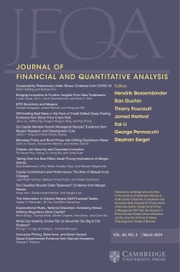Crossref Citations
This article has been cited by the following publications. This list is generated based on data provided by Crossref.
Manconi, Alberto
Massa, Massimo
and
Yasuda, Ayako
2010.
The Behavior of Intoxicated Investors: The Role of Institutional Investors in Propagating the Crisis of 2007-2008.
SSRN Electronic Journal,
Boudghene, Yassine
Maes, Stan
and
Scheicher, Martin
2010.
Asset Relief Measures in the EU: Overview and Issues.
SSRN Electronic Journal,
Luo, Dan
and
Carverhill, Andrew P.
2011.
Pricing and Integration of the CDX Tranches in the Financial Market.
SSRN Electronic Journal,
Wallace, Nancy E.
2011.
The Bear's Lair: Index Credit Default Swaps and the Subprime Mortgage Crisis.
SSRN Electronic Journal,
Luo, Dan
Tang, Dragon Yongjun
and
Wang, Sarah Qian
2018.
Model specification and collateralized debt obligation (mis)pricing.
Journal of Futures Markets,
Vol. 38,
Issue. 11,
p.
1284.
Zadniprovsky, Olexandr
2020.
TOXIC ASSETS AND THEIR EVALUATION IN ACCOUNTING.
State and regions. Series: Economics and Business,
Fleckenstein, Matthias
Longstaff, Francis A
and
Van Nieuwerburgh, Stijn
2020.
Renting Balance Sheet Space: Intermediary Balance Sheet Rental Costs and the Valuation of Derivatives.
The Review of Financial Studies,
Vol. 33,
Issue. 11,
p.
5051.
Cordell, Larry
Roberts, Michael R.
and
Schwert, Michael
2020.
CLO Performance.
SSRN Electronic Journal ,
Carverhill, Andrew
and
Luo, Dan
2020.
Pricing and integration of credit default swap index tranches.
Journal of Futures Markets,
Vol. 40,
Issue. 4,
p.
503.
CORDELL, LARRY
ROBERTS, MICHAEL R.
and
SCHWERT, MICHAEL
2023.
CLO Performance.
The Journal of Finance,
Vol. 78,
Issue. 3,
p.
1235.
Shirkhani, Behrooz
Abdoli, Mohammadreza
Valiyan, Hasan
and
Shahri, Maryam
2025.
Issues and challenges of frozen assets in Islamic financial markets.
International Journal of Islamic and Middle Eastern Finance and Management,
Vol. 18,
Issue. 5,
p.
993.

